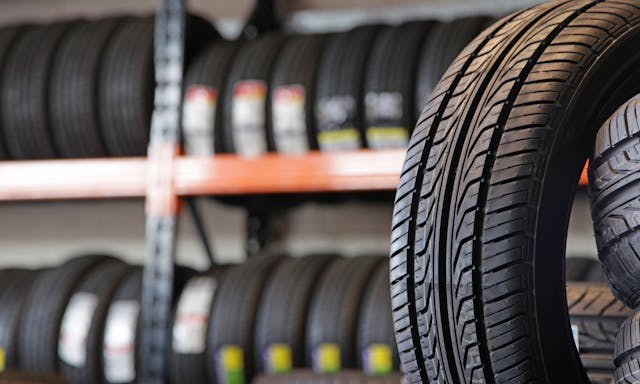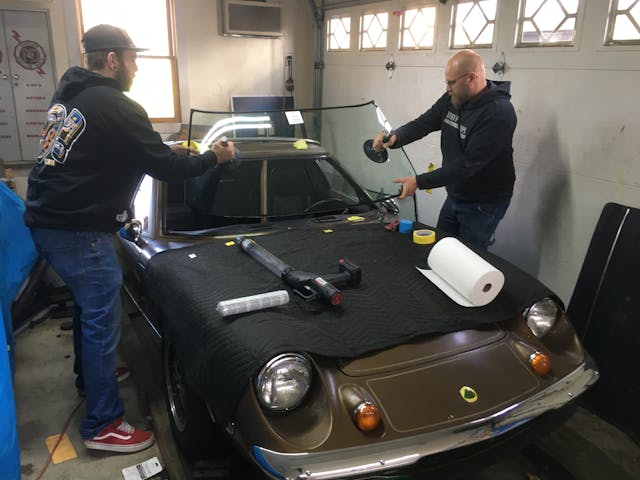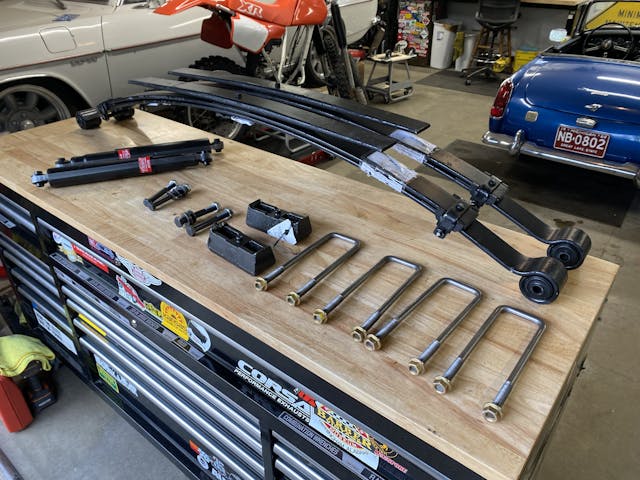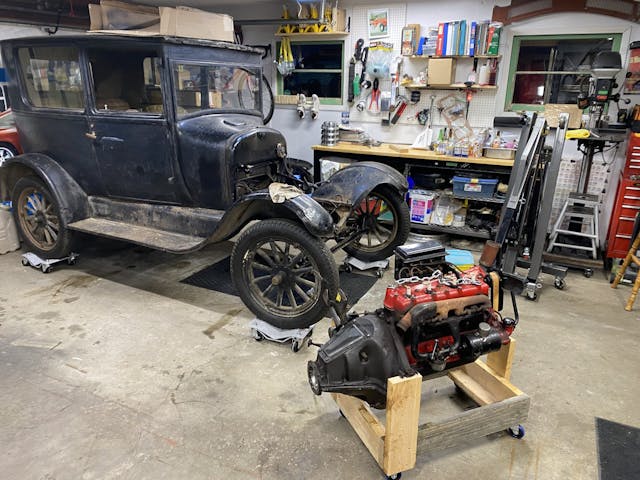5 car parts that look the same despite changing dramatically
Look at the car in your garage. Now look at a Ford Model T. You’re likely seeing two cars that look nothing alike. Well, at least on the macro level. Get down to eyeballing individual pieces and parts, however, and it won’t take long to spot a few bits that actually look pretty close to the same. Are there really car parts that haven’t changed in over a century of production? No, not really, but there are at some that look like they haven’t. Let’s take a peek at five such pieces.
Tires

Treaded, rubber, and round. Simple right? Not so fast. Tires have advanced in so many ways, but just the highlights are compound and construction. The chemical makeup of the tires we buy today is a complex and artfully crafted mix designed to balance wear, grip, noise, and comfort. Tires 100 years ago were still tube-type and were good—if they stayed round and rolling for an extended period of time. Tire construction went from bias ply, where the bands of reinforcing material under the tread are laid at 45 degrees to each other—on a bias—rather than the modern method of radial construction, which puts the reinforcement into the tire both around the circumference and also from bead to bead. This modern design allows for additional tire flex, which can be tuned to fit various situations.
Windshields

It’s clear and keeps the junk flying up from the road from hitting you and your passengers in the face. Well, at least that is what it did back then. Now, windshields are stronger than ever, clearer than ever, and more advanced than ever. Safety glass of today is something many take for granted, and it is likely because many drivers have never seen what happens to plate glass windows in the event of a crash. Early safety glass was even worse.
Now windshields are embedded with sensors and antennae, along with defroster coils and tint. Yes, it’s still a curved piece of glass, but the similarities end there.
Body panels

The idea of body panels took a while to evolve, as the automobile was a novelty for years prior becoming a near necessity. As cars became more reliable, their styling and larger function gained importance and thus body panels became critical. The flat steel panels were structured with wood beneath them, but now the panels themselves are bent and folded in such ways that they often brace themselves. They are also designed to behave with certain manners in the event of a crash, rather than being built as if they were going to be statically installed on a house.
The skin of a car is still the skin of a car, but now exotic materials are more popular than ever. Early cars had all kinds of crazy stuff for body panels, and to be honest, we are happy that carbon fiber, aluminum, and plastics won out over patent leather and wood.
Drum brakes
“If it ain’t broke, don’t fix it” is something many people have learned through experience. The same can be said for OEM carmakers. Drum brakes are not sexy and have their drawbacks but in the grand scheme of things are simple, dependable, cheap to produce, and easy to maintain. Look at vintage cars and you’ll likely see some version of a drum brake. Model A Fords only have three springs per brake backing plate, and the shoes are actuated by a wedge pushing the shoes out in unison.
Modern drum brakes have varying designs that require differing solutions for the one brake shoe over the other, and they are hydraulically actuated with a whole host of springs and levers to incorporate various functions. Are they still drum brakes that function the same? Yes, but once you pull the drum you’d be hard pressed to say they are the same as they have always been.
Shocks

The automobile was born from wagons, and even back when the horsepower came from real horses we knew that solid suspension was a bad idea. Roads were even worse than they are today, and undamped springs can make for a wild ride. The idea of shocks was not something new for cars, but cars really advanced the technology. From lever shocks to the modern tubular design, their function centers around the idea of pushing a fluid through a metered orifice in an effort to slow the motion of the spring or sprung part. What used to be a simple hole has advanced to highly-tunable shim stacks and even electronically adjustable designs that adapt automatically on the fly without the driver even realizing it.
***
Check out the Hagerty Media homepage so you don’t miss a single story, or better yet, bookmark it. To get our best stories delivered right to your inbox, subscribe to our newsletters.



Brake Drums? Only the Tacoma still used them? LOL
and only on the rear wheels at that.
Kyle said drum brakes are easy to service, but if you ask me, they aren’t. I much prefer just removing pads from a caliper and putting new ones in. I’m glad my drum brakes are long gone. Maybe the ’24 Taco will finally join the 21st century. It may be OK with drums in the rear when the bed is empty, but I’ll bet the braking distance grows substantially with a loaded bed. In comparison, our ’04 F150 could actually stop shorter with 1,000 lbs in the bed vs. empty. I attribute that significantly to the rear disc brakes.
1986 GMC C3500 Crew cab dually, rear drum brakes, and it can stop a 35ft camper trailer with no issue, I trust drum brakes for pure stopping power over disc, the biggest disadvantage to drum brakes is brake fade from heat, as no one has made a drilled and slotted drum. Think about the design, disc is two pad being forced against a rotating mass between them. Drum brakes(at least the GM truck versions) have a pin at the top right about the wheel cylinder, the wheel cylinder pushes both shoes out they grab the drum and because of the springs they start to rotate, only for the trailing shoe to get forced into the pin, the leading shoe though continues to want to follow the drum around so while the wheel cylinder pushes the shoes out the leading show also forces the trailing show into the drum, theoretically multiplying the stopping power being applied.
You can get brake steer severe enough to almost rip the steering wheel out of your hands on a front drum brake car if one side is wet but the other is not, that doesn’t happen with disc brakes, another case that can prove drum brakes can create more stopping power then disc.
Your last statement doesn’t prove that drums have more stopping power than discs. It does prove that drums are much worse when wet.
My old 67 Riviera can lock up all 4 wheels with stock drums at 70 mph, I have done it. I would rather have Disc brakes, but honestly for stopping power a 12″ drum would out stop a 12″ disc, once. The issue with Drum brakes is as they heat up they expand, which makes the shoes further from the drum. Disc Brakes do not have that issue.
Your “drums are superior” argument is a total fallacy. Braking power of disc brakes is FAR superior to drum brakes. Don’t take my word for it, but do a little research and you’ll quickly discover the truth.
Kevin- I’m sorry, but the only situation in which drum brakes are superior to discs is at a classic/vintage car show like Pebble Beach, where originality is paramount. Discs shed heat better, are much more resistant to water, are lighter, and pound of foot pressure to braking force (power or unassisted) is vastly increased over drums. My ’04 Tahoe heavy half pushes a snowplow, tows an implement trailer often with a Bobcat aboard, is lifted and runs 20″ wheels and far larger than stock Hankook tires. Other than stock sized slotted rotors and heavy duty commercial pads, my entire 4wheel disc system is ’04 GM factory. And it will outbrake your drum equipped GMC unloaded while carrying the plow and hauling the trailer. I know this cuz I’ve had this *discussion* with reactionary old schoolers every year, and proved it. WayneJG is correct. Do some research instead of believing your “feelings “. Unless you’re showing a prewar vintage auto, discs are vastly superior in every situation. They’re much easier to maintain, too.
Disc brakes are far superior in every way. That fact that one wet drum will cause the other one to “rip the steering wheel out of your hands” proves nothing (except maybe that drums are worse in wet conditions). A single functioning front disc will cause the other to do the same thing. The difference is that it will never happen in the wet with disc brakes.
Discs have a smaller pad surface because the design of them applies better and more even pressure on the rotor then shoes usually will on a drum. Discs also don’t need as much pad contact surface as drums, because they run cooler. Discs shed water and dry much quicker then drums. Discs are lighter reducing unsprung weight, improving vehicle dynamics, and discs are easier to service.
Drums have been a perfectly acceptable way of stopping vehicles for the last 100 years, but their time has past. It’s the 21st century and discs are now the better way to stop a vehicle.
I own a Tacoma. You would lose that bet. When the bed’s empty, heavy braking tends to break the traction. Then that new-fangled anti-skid system kicks in and pumps the brakes. Load my truck down, and the rear end doesn’t break loose. Maybe the same thing was going on with your F150.
You know, I have driven and owned so many cars with four-wheel disc brakes, starting with the ’67 Volvo 140-series that I believe pioneered that concept. Way ahead of their time. I appreciate the performance of disc brakes at all four corners, especially in competition, which I was involved in for a long time. But now my priorities have changed. Living in Ontario, Canada, the salt and sand wreak havoc on the rear discs in the winter. Same for most of the other provinces and territories. I got sick of trying to maintain the rear discs on my vehicles. And if your travel is low mileage, rear discs are a pain as well. Two years ago we purchased a new Hyundai Venue, a small CUV. We specified the Essential model, very basic but well equipped (only thing missing is cruise; don’t need it). Ours is a six-speed manual, believe it or not, and lo and behold comes with rear drum brakes! No longer faced with annual replacement of rear disc equipment because of the inclement conditions. Stops just fine.
Jeez, Jeff, I live in Fargo, North Dakota, USA, and my examination of weather and climate records clearly shows Fargo to be far harsher than Ontario. And here the roads are slathered with deicing salt solutions. Yet, my ’04 heavy half ’04 Tahoe exhibits no unusual rear disc wear- and it’s a snowplow truck driven ONLY in winter. My fronts always need service in the spring, weight of the plow and implement trailer loads the fronts pretty hard. Rears only need service every third year. Dunno what you’re doing, but weather isn’t what’s wrecking your rear discs. Perhaps you could release the parking brake once in a while?
Spark plugs???
Good one!
Spark plugs look pretty much the same today as they did 50 years ago, but most are significantly smaller in diameter, many have much longer threaded noses, and the electrodes are typically made of (or tipped) with platinum or iridium so they last 120,000 miles or more. You usually had to replace the plugs on 1980 & older cars yearly because of wear and lead fouling.
Good article on Why Spark Plugs Need to Be Replaced here:
https://www.aa1car.com/library/cm1196.htm
“Look at the car in your garage. Now look at a Ford Model T.” Hmmm – if I look at the car in my garage, it IS a Model T!
Ha me too. 1920 Touring converted to pickup here
I only said Model T because I was looking at my Model A and it felt too on the nose to say so!
I’ve got one of those too! 1915 T Speedster, 1930 A Town Sedan
Almost ALL large trucks still use drum brakes. Air actuated, but the same design. And yes, they do stop the 80K lbs of vehicle. But let’s go to disk brakes, and the new rotor and pad material. What was a steel disc and asbestos pads in the ’40’s are now carbon/ceramic on high end vehicles.
Any part requiring a magnet…Starter, Alternator/Generator, Speaker. The invention of high powered tiny magnets (to save weight) have made the overall size of these parts dramatically smaller. I first saw them at a Delphi auto parts lab in Indiana in the mid-eighties. A magnet the size of a pea would dent the face of a refrigerator if you just lightly tossed it at the door. Like all GREAT things…Delphi sold it to the Chinese. Fools that we were…all the power in the new EV motors are from this USA invention…now owned but THEM!
I think anything invented in the ’80s would be fair game today. Patents long expired. More than likely, they didn’t sell anything to the Chinese as either they outsourced manufacturing or Chinese companies just stole the tech. It’s what they did, and it’s what they still do.
How about “magnetic braking” {better known as regenerative braking) for the 21st century? Why waste all that energy your engine and / or electric motor churned out just to have the efficiency evaporated into waste heat when stopping? But, always good to have discs and drums as well!
Headlights
Headlights have changed a ton, but they also don’t look the same anymore.
All of the items mentioned are similar to (but different) from today’s cars. The one item that is the same and probably interchangeable for 100 years is the Schrader valve in the tube or tubeless tire.
Another good one!
Bazinga! John King wins!
It is probably an urban legend – but it was stated that everything on a car was invented by 1936. Anything installed in a car after that time is just an improvement on that technology.
Maybe mostly true, but not the fully-electronic computer so important now; many sources agree that was during WWII.
My refrigerator door won’t even hold a magnet, I have to tape the grandkids stuff to the door…
Lights are a big one. Remember going into the parts store and buying a sealed beam for a couple dollars. The headlights on my truck are $ 1000-1200 each from the dealer and at this point in time that’s the only place you can get them and that’s if you don’t mind waiting 6-8 weeks. And that’s what you call progress. Tires! You better watch where you buy them and where they came from. It’s amazing how we get so good at something and then let it go down hill to crap being imported now. More important to keep the Wall Street investors happy
Driveline dependability?
I was giving my 17 yr old grandson heck for not regularly checking his oil!
Made me think that in almost 100k on my F150 I’v probably (maybe) done it a half dozen times.
How about gas delivery, from a simple carburetor up to modern fuel injection?
Electronic distributors. For those with a Jensen/Lotus 907 engine and have made the conversion know what I’m talking about. The distributor is located under the carbs and pulling it out to adjust the points etc is a pain, especially when hot. With an electronic ignition conversion you don’t have to deal with this again however you still need to access to rotate the distributor for timing which is not a big deal.
But I’m still keeping my original distributor in case a big solar flare or Martians (War of the Worlds) fry all electronics! LOL
Years ago, I used to keep a set of points, capacitor and a cardboard match book in my glove box. If my car started running roughly due to the points pitting, I could change them and use the match book as a gauge. My first car with electronic ignition was a 1974 Ford Grand Torino. At 1500 miles, my electronic ignition failed and the car had to be towed back to the dealer. When the electronic ignition module goes bad on older cars, the car is dead!
I remember my Uncle who was a shade tree mechanic would use the striker on a book of matches to file the points and then use the matchbook cover to set the points. He wasn’t educated but was a pretty good Mcgyver 🙂
Same thing happens when your points or condenser crap out – your car is dead and left stranded.
My 1971 Triumph TR6 has had an electronic ignition for over 20 years (I replaced the garbage points system shortly after acquiring it) and it’s never left me stranded – and I never need to adjust point gap or timing. Electronic is set-and-forget!
Steering wheel.
Dashboards.
Gauges.
Schrader valves have stayed basically unchanged for over 100 years.
Good mention!